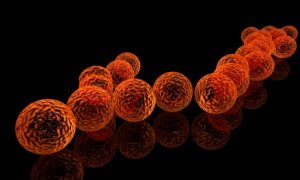
Within pathogenic anaerobic cocci to man, there are cocci:
– Gram positive: Peptococcus and Peptostreptococcus,
– Gram-Negative: Veillonella.
These species occupy a significant place in the isolated anaerobes in pathology, as gram-positive cocci are based on French studies between 11 and 37% of anaerobic strains encountered in hospitals.
I – CLASSIFICATION:
We distinguish among Gram-positive cocci unsporulated four main types which differ on the criteria listed in Table I.
Recent revisions took place between Peptococcus and Peptostreptococcus based on the results of the GC%, whereas before, the distinction was made on the morphology. Schematically:
– Peptococcus are cocci in clusters, pairs, tetrads,
– Peptostreptococcus are cocci in chains for some species (P. anaerobius, P. micros, P. productus), they are in the form of clusters or tetrads P. prevotii and P. magnus.
The species Veillonella parvula is the only species of anaerobic cocci Gram-negative pathogen for humans. The GC is 36-43%. The Veillonella are oxidase (-).
II – HABITAT:
Anaerobic cocci are widely represented in the normal flora of humans, especially at the mouth of the respiratory, intestinal and urogenital tract.
III – PATHOGENICITY:
Germs are found singly or in combination with other species strictly anaerobic and / or aerobic.
The clinical presentations are varied. These cocci are involved in:
– Bacterial and septicemia (including P. magnus)
– Intra-abdominal infections, post surgical,
– Joint diseases (arthritis, often replacements) or bone (osteomyelitis), especially P. magnus,
– Dental infections, head and neck,
– Respiratory infections, female genital infections etc …
Infections with P. indolicus are exceptional in humans.
IV – BACTERIOLOGICAL CHARACTERS:
A – morphological characters:
Gram-positive cocci, which can sometimes take a lying or coccobacillary appearance; They are arranged in pairs, small groups or chains.
The size of the elements is variable, very small for P. microphones (0,3-0,5μm) for large / 1 magnus (0.7-1.2 pm).
V. parvula occurs either in individual elements, or in diplococci, clusters or short chains, the elements are small in size 0.3-0.5 μ m.
B – Cropping characters:
These germs grow easily on different anaerobic usual media (brain heart, Schaedier supplemented with sheep blood …).
In polymicrobial samples, can be used in a selective medium containing neomycin.
P. anaerobius a growth favored by co-culture with Clostridium perfringens, but the mechanism of this stimulation is known.
Culture is relatively slow and the appearance of colonies often asked 48 hours or more. P. Niger developed a black pigment on blood agar. Colonies of convex Veillonella, translucent, give a red fluorescence under ultraviolet light.
C – biochemical characters:
Slow culture often requires a reading time of the biochemical reactions 3 to 5 days.
The main biochemical criteria are given in Table II.
Rapid kits can be used: Miniteck API 20A …
The study of fermentation end products, liquid gas chromatography is also interesting. In particular, it discloses the production of butyric acid and caproic P. Niger, butyric acid and lactic P. tetradius; of acetic acid per every otherPeptostreptococcus … V. parvula produces mainly acetic and propionic acids.
The sensitivity of P. anaerobius sodium sulfbnate polyanéthol (SPS) with an inhibition of at least 12 to 18 mm around the commercial records and the ability of this species to degrade tyrosine constitute extra elements for diagnosis.
IN NUMBERS
COCCI ANAEROBIC GRAM POSITIVE:
– They represent 11 to 30% isolated anaerobic humans
– The relative importance of species among all anaerobes is as follows *
P.magnus 13%
P.asaccharolyticus 5%
P.anaerobius 3%
P.micros 2%
P.prevotii 2%
* Statistics from the Mayo Clinic.
COCCI GRAM NEGATIVE ANAEROBIC:
– Veillonella parvula represents the authors between 1 and 16% anaerobic isolates.
V – BACTERIOLOGICAL DIAGNOSIS:
Samples: they must be carried and transported in accordance with the general rules on levies supposed to contain anaerobic.
Samples containing these cocci are varied: blood culture, pus from abscesses, pus abs, pus bone, puncture fluids (joint, pleural …), genital swabs.
Culture: anaerobic blood culture bottles (preferably without SPS), liquid media (Rosenow or thioglycolate) and solid media separation, non-selective (blood agar …), selective for Gram-positive cocci (blood agar + neomycin and gentamicin).
Incubation is either anaerobic jar or preferably for Veillonella anaerobic chamber.
The crops are often slow and observation should be continued for at least 3 to 5 days.
The identification is based on:
– Morphology, examination of UV in colonies,
– Biochemical galleries, sensitivity to sodium sulfonate polyanéthol (SPS)
– Identification of end products by gas chromatography.
VI – ANTIBIOTIC SENSITIVITY:
Penicillin G is the treatment of choice for infections due to these anaerobic cocci. Clindamycin or chloramphenicol represent alternatives.
All strains are not sensitive to metronidazole and tetracycline are less active.



You must be logged in to post a comment.